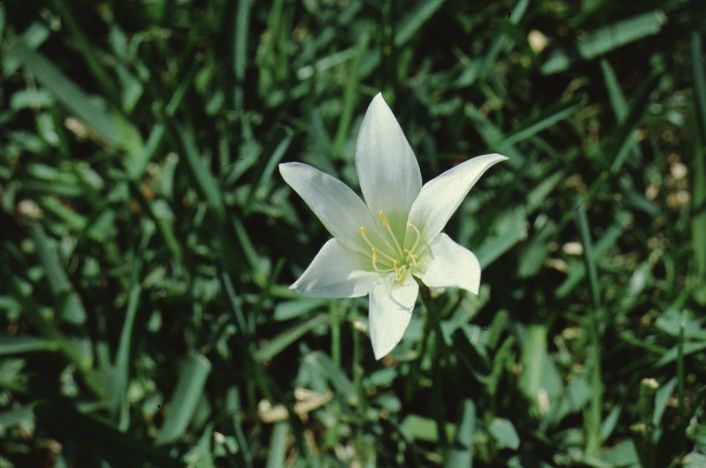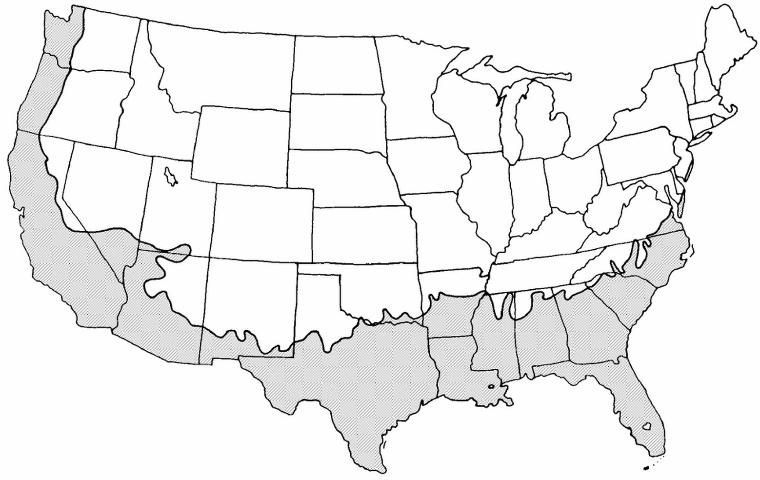Introduction
These dainty, funnel-shaped blooms pop up seemingly overnight after a heavy rain when grown in the wild, appearing in various shades of white, yellow, pink, rose, red, or orange. In cultivation, rain lily will flower throughout the year if kept alternately wet and dry with the majority of blooms produced in late summer or early fall. The narrow, grass-like foliage blends in well in rock gardens, borders, or it can be used in containers.

Credit: Edward F. Gilman, UF/IFAS
General Information
Scientific name: Zephyranthes spp.
Pronunciation: zeff-fer-RANTH-eez species
Common name(s): rain lily
Family: Amaryllidaceae
Plant type: bulb/tuber; herbaceous
USDA hardiness zones: 7B through 11 (Figure 2)
Planting month for zone 7: year-round
Planting month for zone 8: year-round
Planting month for zone 9: year-round
Planting month for zone 10 and 11: year-round
Origin: native to Florida
Invasive potential: not known to be invasive
Uses: naturalizing; edging
Availability: grown in small quantities by a small number of nurseries

Credit:
Description
Height: 0.5 to 1 feet
Spread: 0.5 to 1 feet
Plant habit: upright
Plant density: open
Growth rate: slow
Texture: fine
Foliage
Leaf arrangement: most emerge from the soil, usually without a stem
Leaf type: simple
Leaf margin: entire
Leaf shape: linear
Leaf venation: parallel
Leaf type and persistence: deciduous
Leaf blade length: 2 to 4 inches; 4 to 8 inches
Leaf color: green
Fall color: no fall color change
Fall characteristic: not showy
Flower
Flower color: orange; pink; red; yellow; white; rose
Flower characteristic: summer flowering; fall flowering; spring flowering
Fruit
Fruit shape: oval
Fruit length: unknown
Fruit cover: dry or hard
Fruit color: unknown
Fruit characteristic: inconspicuous and not showy
Trunk and Branches
Trunk/bark/branches: not applicable
Current year stem/twig color: not applicable
Current year stem/twig thickness: not applicable
Culture
Light requirement: plant grows in part shade/part sun
Soil tolerances: occasionally wet; clay; sand; acidic; loam; slightly alkaline
Drought tolerance: high
Soil salt tolerances: poor
Plant spacing: 6 to 12 inches
Other
Roots: not applicable
Winter interest: no special winter interest
Outstanding plant: not particularly outstanding
Pest resistance: long-term health usually not affected by pests
Use and Management
Growing in full sun or partial shade, rain lily is tolerant of various soils and is moderately salt-tolerant. Bulbs can be left in the ground over winter if they are mulched heavily, or they can be lifted and replanted in the spring.
Zephyranthes candida has dainty, white, late-summer to spring blooms; Zephyranthes rosea has rose-pin blooms in late summer; and Zephyranthes sulphurea has soft yellow, mid-summer blooms.
Pests and Diseases
Propagation is by seed or division.
Problems include maggots and chewing insects.
Botrytis may be a problem.